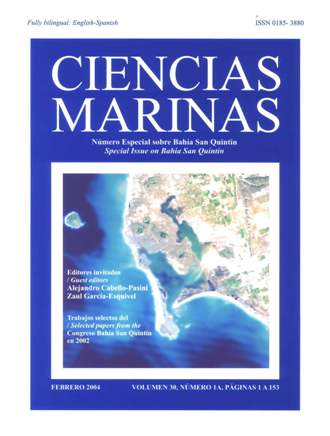Nutrient and phytoplankton dynamics in a coastal lagoon strongly affected by coastal upwelling
Main Article Content
Abstract
San Quintín Bay is a coastal lagoon influenced by the California Current System (CCS) coastal upwelling. Upwelling brings nutrient-rich waters near the bay mouth and tidal currents propagate those waters throughout the bay. Upwelling intensification and relaxation events occur with a period of ~2 weeks, possibly due to the variability of circulation of the CCS. Off San Quintín, the CCS has an offshore component of the flux, causing upwelling intensification events as strong as off Point Conception (34.5°N), with high phytoplankton productivity. At the lagoon's mouth, upwelling is the main cause of variability for all physicochemical properties except temperature. Semi-diurnal tides are the main cause of variability for temperature. Nutrient remineralization at the sediments and turbulence induced by tidal currents and wind waves increase nutrient concentrations in the lagoon. At the heads of the bay, phytoplankton abundance was ten-fold lower, productivity and chlorophyll concentrations were three-fold lower, chlorophyll content per cell was three-fold higher, and turbidity was higher than at the mouth. The few available data suggest the hypothesis that the effect of ENSO events on phytoplankton biomass depends on the interdecadal regime shifts in the northeastern Pacific. At the lagoon's mouth and adjacent ocean, summer salinities as low as 32.4 suggest the arrival of water parcels that originate in the north, possibly the Columbia River estuarine plume.
Downloads
Article Details
This is an open access article distributed under a Creative Commons Attribution 4.0 License, which allows you to share and adapt the work, as long as you give appropriate credit to the original author(s) and the source, provide a link to the Creative Commons license, and indicate if changes were made. Figures, tables and other elements in the article are included in the article’s CC BY 4.0 license, unless otherwise indicated. The journal title is protected by copyrights and not subject to this license. Full license deed can be viewed here.

